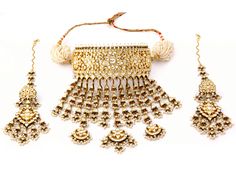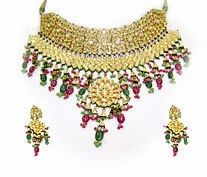Nice Find! "Parvati" head (Gauri) - circa?
I purchased the following "Parvati head" on eBay which arrived today (detailed photos below) for $99.99.
I am looking for any Indophiles who might have expertise to shed light on it's region, circa date of creation, how the brass head is typically incoroprated into use. I personally plan on using this brass Parvati Head as part of a major "project" of mine to establish an Annapurna Murti. It is hollow inside, consists of two parts - the front mask and the back of the Head - welded or cast together as one piece.
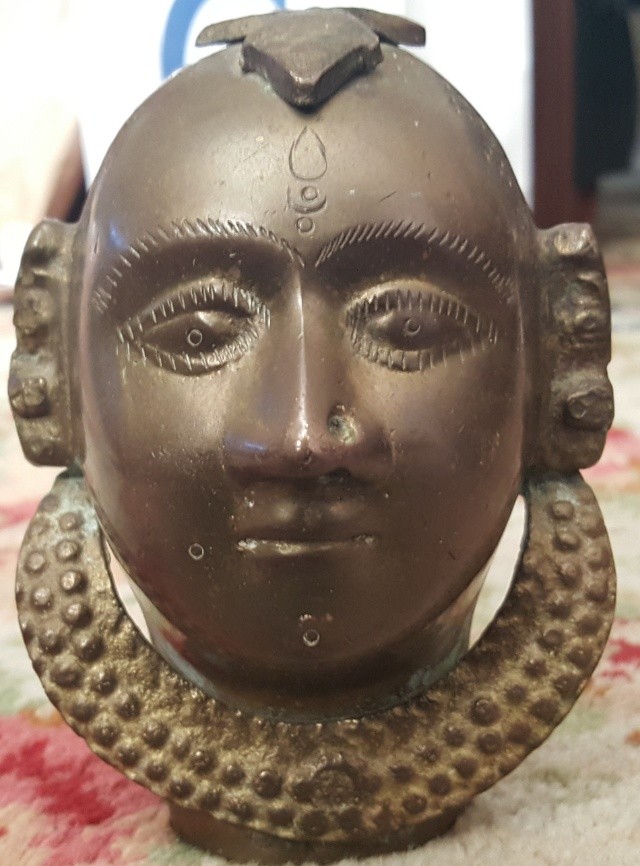
My gut is, the region is Jodhpur. It is modern, since on the lower back of the neck in very tiny punch mark is the word in capital letters I N D I A - but the punch mark dots that spell the word India are not punched in but are like tiny buttons projecting outward. This means on the cast use to make the head, the craftmaker pushed the punch marks as dots INWARD on the actual cast mold itself thus the word "INDIA" would be raised dots extending out when the brass is poured into the mold.
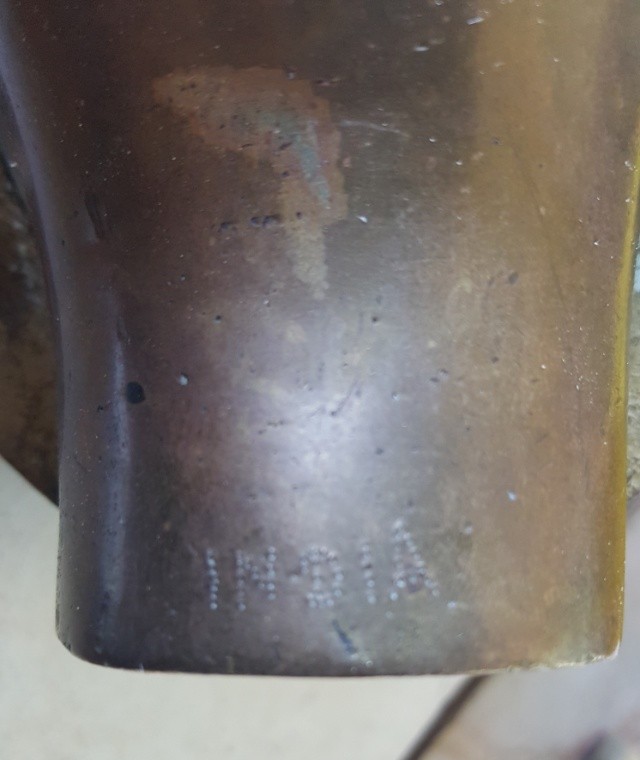
Obviously, the word "INDIA" would not be used on an old piece, if there were any words punched they would be in Devanagari or other Indian script and not English.
But the brass is old, but no real patina, yet old, I can tell. If I were guessing, it is circa 1940s AD, but I could be wrong. The word INDIA may indicate it was for trade to a larger market.
I have seen similar Heads, always identified as either "Parvati" or "Gauri" or "Goddess" Head. There is a murti I have seen in India which clearly has such a Head, even the same size but not exactly the same, which has the Head attached to a body, paint on the face, and clothed.
I also found what looks like the exact same head on Pinterest, painted on the face for the eye brows, lips, eye pupils, and wearing headdress. The murti I mentioned I saw using very like head had a nose ring.
This Head has a hole for a nose ring for the Devi's own left nostril. There is a hair lung on the top of the rather baldly looking head clearly with gaps such that a wig or headdress can be attached to the lung. There is a half-S hook attached to the back of the Head which I think can be used to attach an elaborate crown. The "ears" are rather lacking features of an ear but have knobs which either could pass for ear ornaments or as knobs to attach actual plated silver or other metal ears or actual ornaments of some type afterwards as part of "dressing the Idol".
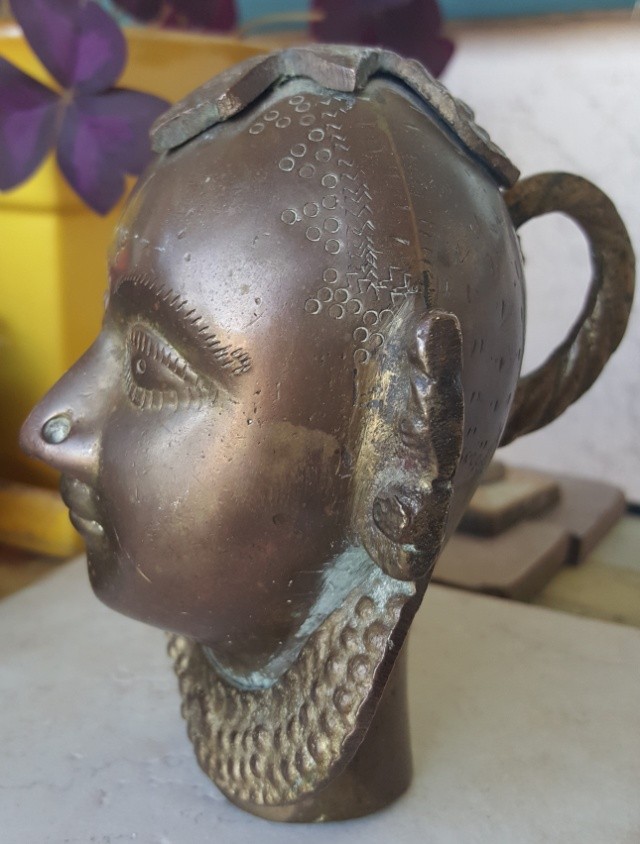
There are very tiny but not excessive use of little ring punch marks to mark the beginnings of a hairline on the baldy head in the front which then become sparse and conservative use of "scratch like" marks of hair on the back of the head, then the hairline of the back of the head is marked by backward Z marks.
The same "pipe" or tube tool used to punch mark the little ring punch marks along the front hairline was also used to punch a dot dead center on the lower chin, and one dot which may representna birth mark on the Devi's own right lower cheek not too far from the lips.
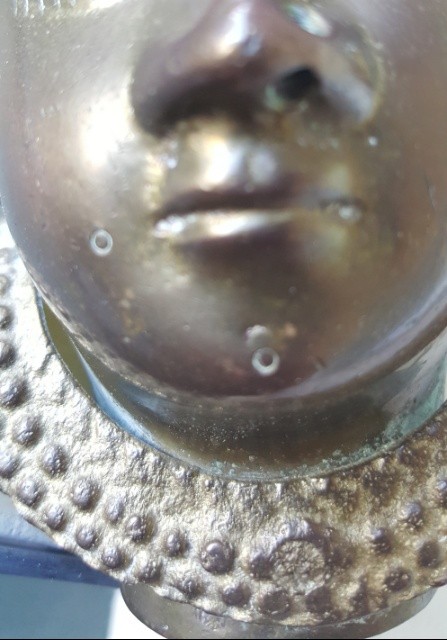
There is an "Royal" style necklace, more Bengali style of Muslim influence, attached behind - but not to - each ear, and welded or heated to the center of the neck, but the necklace otherwise is detached from the Head. I say "Bengali" in that it looks like the "Royal" style necklace (verse skulls) I have seen on Kali Murtis, but the face of this Devi is in no way Bengali but without question, to me at least, Rajasthani in appearance as seen on ****ala Devi. This same necklace, though not exactly the same which here tapers more thinly as it rises to the upper sides of the neck, is like the very elaborate beaded necklace of Gangaur the Goddess in Rajastan.
But the Gangaur festival celebrate of harvest is also celebrated in West Bengal. So this may very well be a Bengali style necklace even though the face is very much Rajastani Gangaur Devi.
The tilak or bindi or head mark on Her forehead is:
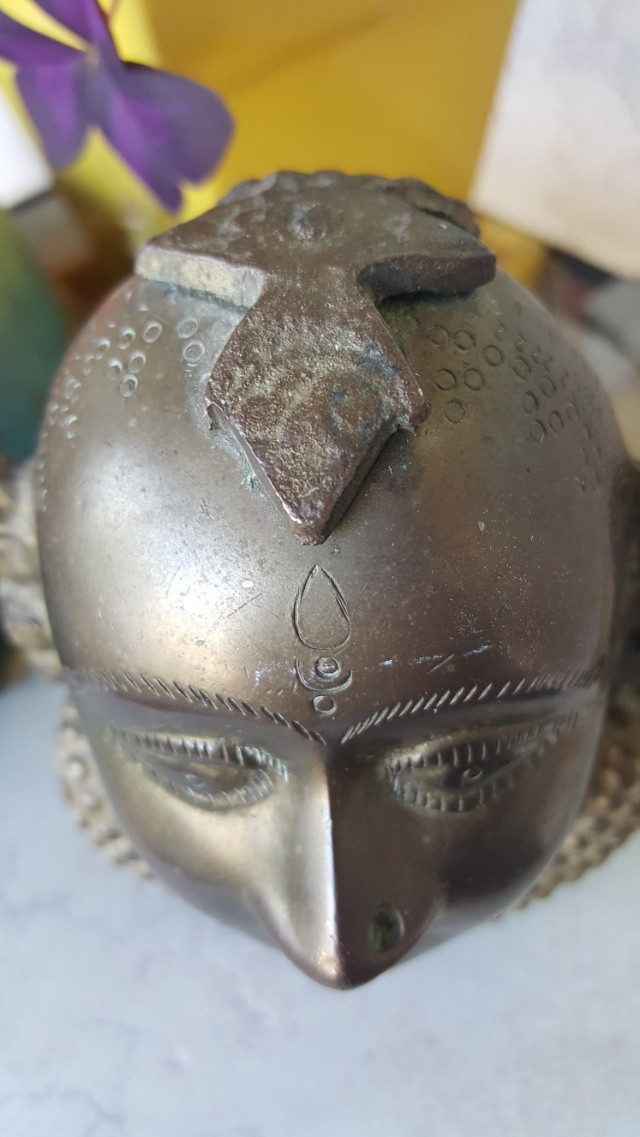
- Lotus Tear Mark - Lotus Eye but only ornamental and not with pupil...
- Under which is again a small punchmark dot using the same punch tool inside a North facing Crescent Moon...
- And under this Crescent yet another punchmark dot.
- This same forehead mark can be seen on Rajastani Goddess Gangaur. But also ****ala Devi found in Jodhpur and in Varanasi. ****ala in West Bengal does not have this mark.
I plan on attaching this beautiful Gauri Head, which might be Ganguar, to a wooden body and I still need to locate two metal hands, a ladle (brass) and a pot, to establish an Annapurna Devi Murti. The Head is 3 and 1/2 inches wide ear to ear, and 4 and 1/2 inches tall from lung to neck.
The difficulty to this project is locating the hands. One hand would need to have fingers mostly closed but with a gap such that the ladle or spoon can be piped in. The other hand can be in any position but will have a pot either in arm or hanging.
Any insights would be appreciated!
I purchased the following "Parvati head" on eBay which arrived today (detailed photos below) for $99.99.
I am looking for any Indophiles who might have expertise to shed light on it's region, circa date of creation, how the brass head is typically incoroprated into use. I personally plan on using this brass Parvati Head as part of a major "project" of mine to establish an Annapurna Murti. It is hollow inside, consists of two parts - the front mask and the back of the Head - welded or cast together as one piece.

My gut is, the region is Jodhpur. It is modern, since on the lower back of the neck in very tiny punch mark is the word in capital letters I N D I A - but the punch mark dots that spell the word India are not punched in but are like tiny buttons projecting outward. This means on the cast use to make the head, the craftmaker pushed the punch marks as dots INWARD on the actual cast mold itself thus the word "INDIA" would be raised dots extending out when the brass is poured into the mold.

Obviously, the word "INDIA" would not be used on an old piece, if there were any words punched they would be in Devanagari or other Indian script and not English.
But the brass is old, but no real patina, yet old, I can tell. If I were guessing, it is circa 1940s AD, but I could be wrong. The word INDIA may indicate it was for trade to a larger market.
I have seen similar Heads, always identified as either "Parvati" or "Gauri" or "Goddess" Head. There is a murti I have seen in India which clearly has such a Head, even the same size but not exactly the same, which has the Head attached to a body, paint on the face, and clothed.
I also found what looks like the exact same head on Pinterest, painted on the face for the eye brows, lips, eye pupils, and wearing headdress. The murti I mentioned I saw using very like head had a nose ring.
This Head has a hole for a nose ring for the Devi's own left nostril. There is a hair lung on the top of the rather baldly looking head clearly with gaps such that a wig or headdress can be attached to the lung. There is a half-S hook attached to the back of the Head which I think can be used to attach an elaborate crown. The "ears" are rather lacking features of an ear but have knobs which either could pass for ear ornaments or as knobs to attach actual plated silver or other metal ears or actual ornaments of some type afterwards as part of "dressing the Idol".

There are very tiny but not excessive use of little ring punch marks to mark the beginnings of a hairline on the baldy head in the front which then become sparse and conservative use of "scratch like" marks of hair on the back of the head, then the hairline of the back of the head is marked by backward Z marks.
The same "pipe" or tube tool used to punch mark the little ring punch marks along the front hairline was also used to punch a dot dead center on the lower chin, and one dot which may representna birth mark on the Devi's own right lower cheek not too far from the lips.

There is an "Royal" style necklace, more Bengali style of Muslim influence, attached behind - but not to - each ear, and welded or heated to the center of the neck, but the necklace otherwise is detached from the Head. I say "Bengali" in that it looks like the "Royal" style necklace (verse skulls) I have seen on Kali Murtis, but the face of this Devi is in no way Bengali but without question, to me at least, Rajasthani in appearance as seen on ****ala Devi. This same necklace, though not exactly the same which here tapers more thinly as it rises to the upper sides of the neck, is like the very elaborate beaded necklace of Gangaur the Goddess in Rajastan.
But the Gangaur festival celebrate of harvest is also celebrated in West Bengal. So this may very well be a Bengali style necklace even though the face is very much Rajastani Gangaur Devi.
The tilak or bindi or head mark on Her forehead is:

- Lotus Tear Mark - Lotus Eye but only ornamental and not with pupil...
- Under which is again a small punchmark dot using the same punch tool inside a North facing Crescent Moon...
- And under this Crescent yet another punchmark dot.
- This same forehead mark can be seen on Rajastani Goddess Gangaur. But also ****ala Devi found in Jodhpur and in Varanasi. ****ala in West Bengal does not have this mark.
I plan on attaching this beautiful Gauri Head, which might be Ganguar, to a wooden body and I still need to locate two metal hands, a ladle (brass) and a pot, to establish an Annapurna Devi Murti. The Head is 3 and 1/2 inches wide ear to ear, and 4 and 1/2 inches tall from lung to neck.
The difficulty to this project is locating the hands. One hand would need to have fingers mostly closed but with a gap such that the ladle or spoon can be piped in. The other hand can be in any position but will have a pot either in arm or hanging.
Any insights would be appreciated!

